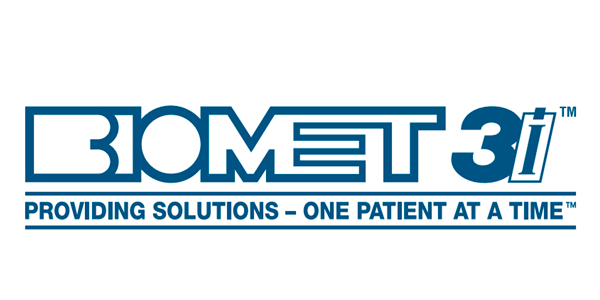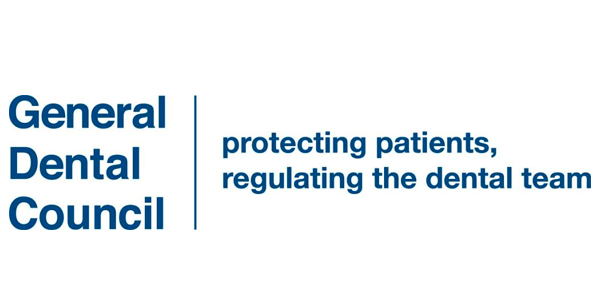This article gives you general information about Dental Implants, it is intended to give you all the information you need so please take your time to read through it.
There are many positives to the treatment but also some negatives that you should be aware of. If you do not feel you have all the information you require, please ask, we are here to help!
Replacing missing teeth – your options
It is important to be aware that implant solutions are not your only option to replace missing teeth. If you like the idea of any of these options, then please call us to discuss your suitability.
Option 1 – No Treatment – Leave the Gap

Not every tooth needs to be replaced, you could leave the gap, but may benefit from the following:
- Improved appearance by closing the gaps in your smile
- Improved eating ability
- Protect your teeth e.g. if you lose too many back teeth, you use your front teeth excessively risking wearing them out or making them wobble.
Option 2 – Dentures
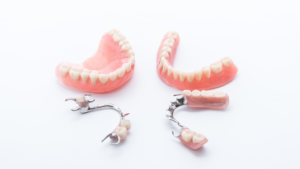
What are these? These are plastic teeth of various colours and plastic pink gum. They can replace single or multiple teeth.
How long will it take to make? Usually 4-6 appointments with at least 1 week between each, so approximately 4-6 weeks.
Important to accept:
- They are not fixed securely in your mouth and predominantly sit on your gum SO THEY WILL MOVE during eating and talking and are REMOVABLE, even if denture “glues” are used or “claps” that grip to any natural teeth.
- Upper dentures generally COVER THE ROOF OF YOUR MOUTH, even if it’s just for one tooth. This can change your speech and ability to taste food as well.
Option 3 – Resin bonded bridge
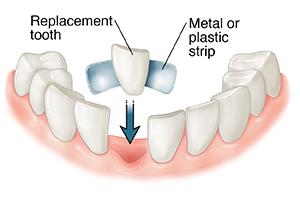
Closeup of resin-bonded bridge being fitted on prepared teeth.
What are these? These usually replace one tooth, and most often small front teeth only. The tooth is plastic or porcelain and uses a silver colour metal wing to stick to a good tooth next to the space.
How long will it take to make? Usually two appointments with at least 2 weeks between each.
Important to accept:
- They do tend to come off from time to time and you will need to visit a dentist to stick it back on. There is a free incurred to have them stuck back on.
- Occasionally some of your healthy tooth needs to be cut to allow the wing to sit correctly or allow room against the tooth opposite it.
Option 4 – Traditional Bridge
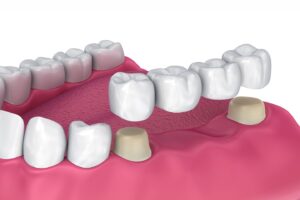
What are these? These most commonly replace one tooth, but in specific situations can replace more teeth. They are made out of porcelain outer shell with most commonly a silver coloured metal inner shell. One or two healthy teeth next to the gap need to be trimmed to allow the bridge to grip.
How long will it take to make? Usually 2 appointments with at least 2 weeks between each.
Important to accept:
- Healthy teeth need to be cut – this may lead to the tooth dying and requiring the nerve being removed and a root canal filling to save it, this incurs extra fees. The tooth will also be weakened once cut.
Option 5 – Dental Implant

What are these? A dental implant is essentially a type of anchor made titanium which is inserted into the jawbone and provides the foundation for support of an artificial tooth or teeth. So the implant itself is actually just the bit which is inside the bone. Unlike a bridge, healthy teeth do not need to be cut. Unlike a denture, these are fixed in your mouth. They are therefore most like “real teeth”.
How long will it take? Usually 5-6 appointments over a 4-6 month period. This takes longest because we need to respect the bodies natural healing times.
Important to accept:
- Longer treatment period
IMPORTANT – FOR ALL ARTIFICIAL TEETH SOLUTIONS
ALL OPTIONS HAVE COMPRISES: It is important to understand that there are certain limitation to anything manmade. Just like an artificial limb is a tremendous help to an amputee, IT IS STILL A COMPROMISE. The cosmetics will be different to real teeth (the tooth part and the gum part).
NO OPTION IS GUARANTEED TO LAST FOREVER: Not even your real teeth always last forever – but some can! As with any material, like a car engine or a pair of shoes, teeth, dentures, bridges, implants can all suffer mechanical failure through fracture or fatigue, so you may need these redone in the future. How long will it last? No one can tell for certain.
NO OPTION IS MAINTENANCE FREE: ALL these options require you to keep your mouth clean on a daily basis. It is also advised for you to visit a dentist at least once a year to ensure any problems are caught early and not to wait until you have any troubles.
Implant Treatment Process
What occurs depends on your individual circumstances. Treatment involving implants is not the same for everybody or for every implant, so the way it is done may be different to someone you know, or another implant you may have had already. Some steps can actually be combined on occasions, but often equate to one step per appointment.
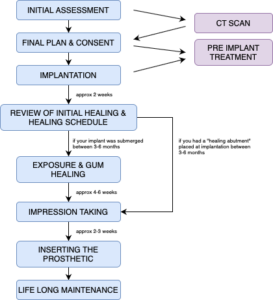
How long will it take? Length of treatment depends on your individual situation. The pretreatment necessary is the largest variable. Some people will need many appointments to make their mouths healthy prior to implantation, others may require bone grafting prior to implantation then time for it to heal and mature, other people may need no pre treatment at all.
But, in general, even with no pretreatment requirements, implant restorations usually take several months from diagnosis to insertion of the prosthetic, and multiple appointments. We need to respect the natural healing process of the body.
IMPORTANT – FOR ALL TREATMENT INVOLVING DENTAL IMPLANTS
SEVERAL MONTHS TO COMPLETE TREATMENT (4-6 MONTH AVERAGE): If you want a quick solution, dental implants are not your best option.
MULTIPLE VISITS TO THE DENTAL PRACTICE (7-8 APPOINTMENT AVERAGE): You may need to take time off work or rearrange your usual activities around dental appointments.
NO GUARANTEE ON HOW LONG THE PROCEDURE WILL TAKE: It may take longer or shorter than planned.
Initial Assessment
Before any implants can be placed, time is taken to decide the best method. The amount of planning involved depends upon the complexity of the treatment. This mostly takes one appointment to gather the data, and a second appointment to talk through the plan with you, but in more complex cases three or four appointments may be required to formulate and agree to your exact plan.
A full mouth check (all the time)
Every patient will receive a full mouth examination to assess the health of any remaining teeth and the gum and bone around them. Before carrying out dental implant treatment procedures, treatment of dental decay or gum disease may be required.
Photographs (most the time)
As they say, “a photo is worth a thousand words”. A series of photos will be taken during the planning phase. A lot of work is done while you are not present, so a picture will be useful to view when making decisions.
X-Rays (most the time)
My eyes alone won’t be able to see below the gum, so an x-ray of your mouth would be required. Dental implants require bone to surround them, so the x-ray will help me measure how much is available. It will also help me locate parts of your anatomy, such as nerves and natural voids in the bone known as sinuses.
CT Scan
In some patients additional information is required. These incur additional fees. Sometimes a special scan is required known as a CBCT scan. X-rays only show you jawbone in two dimensions, i.e. height and width only. A CBCT scan will produce an image of your jawbone that is 3D so that height, width and depth is measured.
This is now always required, and is most often needed when all the other information is not enough to fully measure the amount of bone available or the position of nerves and sinuses.
If this is required, an additional fee is often charged, the exact amount depends upon the scanning department and the size of the scan required.
Final Plan & Consent
Once we have all the information required, we need to discuss the final plan, and ensure you are happy with the planned procedure and your alternative options including no treatment.
If you agree to the treatment, you will be asked to sign a consent form to record your decision.
If you decide later that you don’t want to go ahead with the treatment, you are always entitled to say so even if you have already signed the form. However, if you have already begun active treatment, then it may not be in your best interest to discontinue, and this would be best discussed with your dentist before making the final decision.
IMPORTANT – FOR PLANNING AND CONSENT
SIGN ONLY IF YOU’RE HAPPY: Only sign this declaration if you are happy you have received all the information required for you to make a decision.
PLANNING COSTS: If you decide after the planning stages you do not wish to proceed with dental treatment, there will be no refund of any payments made. This is the fee for initial assessment and any scans taken.
Pre Implantation Treatment
It may be required that some treatment is carried out before the implant can be placed. This may include:
- Treating gum disease
- Removing teeth
- Treating decay
- Manufacturing dentures or other temporary devices such as a dental bridge
- Pre implantation bone grafting (block grafts, sinus lifts etc)
- Models of your teeth to be fabricated
- Manufacturing of an implant replacement guide
- Ordering a “wax-up” – a type of blueprint for the future treatment
Dependent on the exact pre-treatment required it may take one appointment or many more. Further details of the exact treatment required, it’s timing and it’s costs will be discussed separately.
Implantation
What happens on this day? This is the day that the implant or implants are to be placed.
No pain – numbing: You will be numb during the appointment so you should feel no pain once the injections are done. The numb feeling usually lasts 3-5 hours. You will however feel pushing and vibrations – no amount of anaesthetic removes this sensation.
Trying to relax: In most cases you are awake throughout the procedure. You could bring along some music to listen to if you have a music player – this can help people relax.
How long is this appointment? The time it takes to do varies from person to person, but we book out plenty time so there is no rush during the procedure.
Stitches: In almost all cases you will have some stitches afterwards. These are either dissolvable or non-dissolvable. At the visit arranged after your implantation, these stitches are often removed, but sometimes loosen before this.
“Healing abutment” or “submerged”: Once the implant/s is inserted they will either be submerged so you cannot see it, or a healing abutment will be placed. A healing abutment will look like a small silver disk sticking through your gum. See the photograph below:
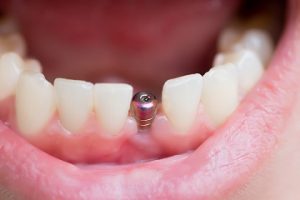
If you need a bone or gum graft to help the implant: At the planning stage, you may not have enough bone or gum to hold the implant in, so a graft may be needed.
For small defects: We put the graft and the implant in at the same appointment.
For large defects: This is when we put the graft in before the implant.
Graft materials: The materials we use to fill out the bone or gum defect is either:
- Synthetic man made bone substitution
- Bone previously from Cow (most commonly used in implant dentistry)
- Material previously from Pig
Below is a diagram of bone graft being placed in the defect to widen the bone, then once the bone has healed the implant can be placed. You can sometimes place the implant at the same time as the graft.
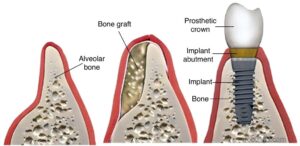
IMPORTANT – PROBLEMS THAT MAY OCCUR DURING IMPLANTATION
Bleeding: This may occur during treatment in which case measures will be taken to cease the bleeding. After you leave the dental practice you may notice bleeding. This can often be stopped with applied pressure using a clean cotton gauze from a first aid box for 10 minutes.
Bruising: You may find some bruising on your face or within your mouth. This generally clears up 2 weeks after treatment.
Pain: During treatment you will be numbed up, so after the injection you should not feel anything. After the anesthetic wears off (often 3-5 hours later) then you may require to take some anti inflammatory or pain relievers as and when required, but generally pain will settle fully 2 weeks after treatment.
Damage to a nerve: There are nerves throughout your face and jawbone. The planning phase and care during treatment intends to reduce the risk to any nearby nerves. The nerve may be fully damaged and may never heal leaving you with a numb feeling to your lip, tongue or cheek. It may be partly aged giving you a tingling feeling on your lip or tongue or cheek. Healing may occur, but this can be unpredictable. The highest risks are when having lower back teeth replaced with implants.
Perforation into a cheek or nasal cavity: As for nerve damage, the planning phase and care during treatment should minimise the change of this occuring. Minor perforations generally cause no problems, but larger defects can leave you with symptoms of sinusitis and further surgery may be required for this to be repaired.
Infection: Even though the procedure involves working in a sterile method, infections may occur. Infections may require further intervention to control it or to repair any damage it causes.
Stiffness in jaw/facial/neck muscles and limited mouth opening: Due to the length of time during the procedure it is not unusual for you to feel some stiffness in your face and neck muscles, similar to muscles soreness after being to the gym. This should return to normal after a period of resting the muscles and a soft easy to chew diet, often recovering within 2 weeks.
Tissue discolouration: Particularly relevant if you had a gum graft, then the colour of the gum may not fully match. It can be a darker colour (purples, blacks) or even lighter (white or yellow) which can all be normal. Any concerns, let us know.
Numbing feeling: This feeling lasts approximately for 3-5 hours. During this time caution must be made so you don’t accidentally bite yourself.
Post implantation instructions: APPENDIX B has the instructions you must follow after your implantation treatment, This is vital to ensure optimum healing conditions.
Allergies: We mostly give you antibacterial and anti-inflammatory medications. Although you may not have had a problem with them in the past, some people develop allergies which may resort in you seeking further medical attention.
Healing abutment coming off: If you had a healing abutment placed, this can sometimes unscrew itself either coming off or becoming loose. Let us know if this occurs so we can advise what to do, which is usually to come in to have it replaced. Don’t try to do this yourself.
Review of Initial Healing & Healing Schedule
Review of healing: As with the planning and surgical stages, the healing phase varies for each individual treatment.
The first scheduled appointment is often around 2 weeks after the implantation, Don’t wait until this if you have any problems or concerns. Give us a call anytime. Because problems can be “silent” and you may not be aware of them, I like to check at this 2 week point to see how your healing is occurring. At this point we will decide to remove any stitches or leave them in.
Healing schedule: You may read about “teeth in a day” or “immediate loading implants”, when a patient has an implant placed and on the same day something is attached to this, most commonly a temporary crown, temporary bridge or temporary denture. These treatments are currently not the usual, and certain conditions must be met before this procedure can be done successfully.
Most commonly a healing period that varies between 3-6 months dependent on how strong your bone is, the amount of grafting that you may have needed, the location in your mouth and the planned prosthetic. This healing period is required to ensure the bone has healed fully so it is strong enough to support your prosthetic teeth. This bone healing is known as Osseointegration.
An analogy is having a broken arm fixed by a surgeon, or a hip replaced. The advice most commonly given is to rest and gradually get back to your normal conditions. They often wouldn’t advise you to go the gym to lift heavy weights or run a marathon.
IMPORTANT – PROBLEMS THAT MAY OCCUR IN HEALING
The implant may not integrate – it remains loose: It is possible that the expected healing does not occur and the implant does not “bond” to the bone.
We cannot accurately predict for an individual what the chance of success will be. The reason for this is that we cannot accurately predict the bone and gum healing because the capability of any particular patient can vary, although we know that the overall success of the implant “integrating” in a healthy patient is generally very high (some studies quote 96% success) – no treatment has 100% success.
Certain medical conditions and medications such as diabetes, excessive alcohol consumption, smoking, blood diseases and anaemia, immune deficiencies, steroids, osteoporosis and it’s treatments, or radiation therapy may reduce the initial integration and reduce long term survival.
If our implant fail to integrate within the first six months of placement, I will remove it and replace/redo it free of charge in healthy individuals with no complication medical problems, after a suitable healing period. If however the second implant fails to integrate, then a third attempt will not be performed and no refund can be made.
The healing abutment may come off: If your implant is not submerged, the healing cap can loosen off. This may simply need retightened, please let us know immediately.
The temporary bridge/denture/crown may break or come off: The temporary materials are not made as strong as the permanent restoration, so it may break or chip. This can be an inconvenience to you which we can’t foresee. Let us know immediately and I will rectify this.
What next? Your next appointment will be scheduled 3-6 months after implantation. As long as the implant has integrated.
If your implant is submerged – Your next appointment will be step 5, exposure and gum healing.
If your implant has a healing abutment – Your next appointment will be step 6, impression.
Exposure & Gum Healing
If your implant was covered over, then we need to locate it under the gum and place a healing abutment upon it. This allows the gym to start shaping to a more natural appearance. The healing abutment looks like the images below.
Occasionally a temporary tooth is attached on this visit. This sometimes incurs an extra charge, but allows you to start seeing the real tooth or teeth in position so you can assess shape and size while the gums heal.
The gum needs 4-6 weeks to heal before the next stage occurs. If you are wearing a temporary denture or bridge, it will need to be adjusted to allow the healing abutment to sit under it.
Impression Taking
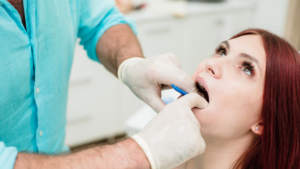
Once healing of the implant and the gum has occured, then your permanent crown, bridge or denture can be manufactured.
To do this you will need an impression. This is a mould taken of your mouth. This is then sent to a dental laboratory to fabricate your bespoke prosthetic teeth. This can take 2 to 4 appointments to complete.
The material that your restoration will be made of will be picked according to the budget, the strength required and the cosmetic result desired. This is often a mix of high quality metals, ceramics and resins.
Inserting the Prosthetic
Once the laboratory has fabricated your prosthetic, the healing abutment or temporary prosthetic is removed and your permanent prosthetic teeth will be inserted. This is either cemented or screwed in.
Cement retained prosthetic: These come in two parts. Firstly the abutment is screwed onto implant. The crown can then be cemented onto the abutment using a type of glue.
Screw retained prosthetic: These come as one part. The whole part is screwed directly onto the implant. The “access” holes in the prosthetic where the screw was put through is filled in using a plastic “bung”.
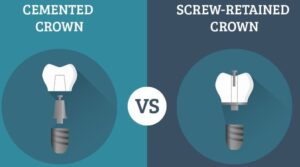
IMPORTANT – PROBLEMS THAT MAY OCCUR IN RESTORING
The cosmetics may not be perfect first time: In this situation, further appointments will be required to rectify this until we are both happy with the appearance. However, there are limits with man made materials which we need to accept, although we aim for the best result possible.
The bite may not be correct: Your new restoration may feel a bit strange to begin with when you bite your teeth together, but with time it often feels better. Sometimes a small amount of grinding is required until they feel right. You need to let me know if you have any concerns.
Black triangles: Because the gum around implants are different to natural teeth, they can heal differently meaning they look flatter and could leave a gap between the teeth known as “black triangles”. Occasionally small amounts of filling materials will be required to fill this space in.
Gum heights: The gum level around the implant is often not the same as a natural tooth. This can make the tooth with an implant on it look longer. We aim to make it as close as possible, but this is not always achievable.
Speech changes: At the provision of new restoration you may notice a slight change in your speech. A period of adaptation will be required.
Lifelong Maintenance
The implant and the restoration attached to it needs care, just like a natural tooth would. This includes:
- Meticulous daily brushing with flouride based paste and mouth rinses.
- Advised 6-12 months visits to see a dentist to examine your implants. Problems may be silent that you are not aware of. A dentist can catch a disease early and advise you on the best treatment for this.
- Report immediately any evidence of pain, swelling or inflammation around the implants or any problems with the attachments or a change in the bite.
IMPORTANT – PROBLEMS THAT MAY OCCUR FOREVER ON
The bone around the implant becomes destroyed: This is known as “loss in integration” and may occur in a process known as “peri implantitis”. If a minor amount of bone is lost, then treatment can occur with a bone graft. If a major amount of bone is lost, then the entire implant may need replaced. Additional fees will be required if occur 12 months after implant placement.
The gums around the implant become inflamed and bleed: This is a disease known as “peri mucocitis”. Treatment is often via deep careful cleaning around the implant. Additional fees will be applied for deep cleaning around your implant.
The restoration/implant/screw may break and need replaced: With daily use of your mouth and teeth, the materials may fatigue causing them to break. These will need repaired, and will incur additional fees.
If you receive trauma to your teeth or face or your clench/grind your teeth, then a grinding or mouth guard is advised to be worn. This will incur additional costs.
The restoration may wear and look old and need replaced.
Your Options During Implant Healing
Why? During dental implant treatment, there are healing times that need to be respected, so in most cases you will not have your final prosthetic tooth fixed to your implant for a few months. Quite often the implant is actually under your gum for a few months to allow the bone to heal, then you will have a healing abutment placed to allow the gum to heal prior to having your final prosthetic tooth made.
During this time you have a few options, each have their advantages and disadvantages, as well as different costs.
Option 1 – Leave the Gap
You could choose just to accept the gap for the healing period. This is typically 4-6 months until your final prosthetic will be fixed.
Advantages: It costs you £0. The gum above the implant is not compressed, so it’s healing is even more protected.
Disadvantages: On some occasions the teeth either side can move into the space, although this is often not a big concern over such a short period of time.
Option 2 – Removable plastic denture
You could choose to have a removable plastic denture to fill the gap. This is a plastic pink gum and a plastic tooth or teeth. It is removable and will move during eating and talking so a fixative glue is often required to make it comfortable and more stable. Upper dentures need to cover the roof of your mouth, so speech and taste will be different.
Advantages: Relatively cheap compared to temporary bridges. Approximately £150-£200. If it falls out, you can put it back in yourself, and don’t need to see a dentist. Makes each dental visit easier, and less time as it can be inserted and removed within seconds.
Disadvantages: Upper dentures cover the roof of your mouth, which some people dislike. They are movable, so eating and talking will take time to get used to. They can place pressure on the gum above the implant, so a space is often required between the gum and false tooth – this can trap food. Plastic teeth not as life like as natural teeth, so colour texture and translucency may be different.
Option 3 – “Essix-Style” Temporary Tooth
This is a removable tooth that uses a clear covering made out of firm plastic that clips over your teeth, similar to “invisible braces”.
Advantages: Relatively cheap compared to temporary bridges. Approximately £100. They do not cover the roof of the mouth, unlike option 2. They do not place pressure on the gum allowing stress on the healing implant, unlike option 2. Less speech impact compared to option 2. Less moving during talking and eating than option 2.
Disadvantages: You may feel initially the clear covering looks strange, but at a social distance this is less notice-able.
Option 4 – Temporary Resin Bonded Bridge
The tooth is plastic or porcelain and uses a silver colour metal wing to stick to a good tooth next to the space.
Advantages: They are stuck to neighbouring teeth near the gap so don’t cover the roof of the mouth. They don’t move during eating or talking. If ceramic is used, it is more life like than option 2 or 3. They do not place pressure on the gum. The supporting tooth may look darker due to the metal shining through.
Disadvantage: They do come off frequently and you will need to attend a dental practice to have them put back on. You will have a gap while waiting for your dental appointment which may not be the same day. They cost the most, approximately £300. At each appointment you will need it removed and then recemented. This takes extra time, and can damage the temporary bridge or the tooth during the process.
Option 5 – Temporary Fixed Bridge
This is a plastic material that moulds around one or two of the neighbouring teeth near the gap. This option is only available if your neighbouring tooth or teeth is having a crown replaced or a new crown made, in which case you can temporarily utilise that tooth to also fill the gap.
Advantage: They are stuck to the neighbouring tooth near the gap so don’t cover the roof of the mouth. They don’t move during eating and talking. They do not place pressure on the gum. Cost no additional fee – this is part of the crown costs. £0.
Disadvantage: Can come off occasionally – but much less often than option 4 (resin bonded bridge). Colour options are limited, but can look good at social distances.
IMPORTANT FOR ALL TEMPORARY OPTIONS
- They are NOT a comparison to your final prosthetic.
- The colour choice is limited
- The materials are more fragile so may fracture
- They may pick up stains from your food and drinks more than your final prosthetic
- During gum healing, when a healing abutment is placed, then option 2,3,4,5, would need adjusted to make space



